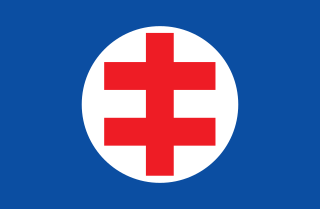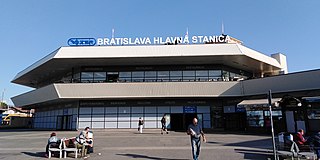Related Research Articles

Czechoslovakia, or Czecho-Slovakia, was a sovereign state in Central Europe, created in October 1918, when it declared its independence from Austria-Hungary.
From the Communist coup d'état in February 1948 to the Velvet Revolution in 1989, Czechoslovakia was ruled by the Communist Party of Czechoslovakia. The country belonged to the Eastern Bloc and was a member of the Warsaw Pact and of Comecon. During the era of Communist Party rule, thousands of Czechoslovaks faced political persecution for various offences, such as trying to emigrate across the Iron Curtain.
The History of Czechoslovakia from 1989-1992 is the period in Czechoslovak History that began with the Velvet Revolution from November 16-24 1989 that overthrew the communist government, and ended with the Dissolution of Czechoslovakia on November 25, 1992.
With the collapse of the Habsburg monarchy at the end of World War I, the independent country of Czechoslovakia was formed as a result of the critical intervention of U.S. President Woodrow Wilson, among others.

Hlinka's Slovak People's Party, also known as the Slovak People's Party or the Hlinka Party, was a far-right clerico-fascist political party with a strong Catholic fundamentalist and authoritarian ideology. Its members were often called ľudáci.
The Slovak National Party was a Slovak conservative and nationalist political party in the Kingdom of Hungary and then in Czechoslovakia from 1871 to 1938. The post-Velvet Revolution party with the same name sees the historical one as its ideological predecessor.

Bratislava main railway station is the major railway station in Bratislava, Slovakia. It is located near Šancová Street, around 1 km or a 15 min walk north from the historical part of the Old Town.

The First Czechoslovak Republic, often colloquially referred to as the First Republic, was the first Czechoslovak state that existed from 1918 to 1938, dominated by ethnic Czechs and Slovaks, the country was commonly called Czechoslovakia, a compound of Czech and Slovak; which gradually became the most widely used name for its successor states. It was composed of former territories of Austria-Hungary, inheriting different systems of administration from the formerly Austrian and Hungarian territories.

Czechoslovakism is a concept which underlines reciprocity of the Czechs and the Slovaks. It is best known as an ideology which holds that there is one Czechoslovak nation, though it might also appear as a political program of two nations living in one common state. The climax of Czechoslovakism fell on 1918-1938, when as a one-nation-theory it became the official political doctrine of Czechoslovakia; its best known representative was Tomáš Masaryk. Today Czechoslovakism as political concept or ideology is almost defunct; its remnant is a general sentiment of cultural affinity, present among many Czechs and Slovaks.

The Marxist Left in Slovakia and the Transcarpathian Ukraine was a political organisation in eastern parts of the First Czechoslovak Republic. It was one of the forerunners of the Communist Party of Czechoslovakia.
The Hungarian-German Social Democratic Party was a social democratic political party in Slovakia. It was founded in 1919 by social democrats from ethnic minority communities. The party had a German and a Hungarian section. The German and Hungarian social democrats in Slovakia had developed an antagonistic relationship with the Slovak social democrats, who had merged into the Czechoslovak Social Democratic Workers Party as Austria-Hungary was broken up after the First World War. Issues of contention between Hungarian/German and Slovak social democrats included views of the February Strike of 1919 and the Hungarian Soviet Republic.

Paul Wittich (1877–1957) was a Carpathian German social democratic politician in Slovakia. He was a prominent labour leader in Pressburg. During a few days around New Year's Eve 1919, he led a workers militia that vied for control of the city. After the integration of Pressburg into Czechoslovakia, he sat in the national parliament.
Westungarische Volksstimme was a German-language weekly newspaper published from Pressburg.
Slovenské robotnícke noviny was a Slovak-language social democratic newspaper issued from Pressburg, founded in October 1904. The newspaper was economically and politically supported by the Czech social democrats in Vienna. Emanuel Lehocký was the editor of the newspaper.
This article describes ethnic minorities in Czechoslovakia from 1918 until 1992.
Stavitel'ský Robotník was a Slovak language newspaper published by the Hungarian Building Workers Union. It was the first Slovak-language trade union newspaper; the Hungarian Building Workers Union created the paper due to its substantial Slovak membership. Its first issue was published on September 1, 1903, and subsequent publication was sporadic.
Union was a central trade union organization of Hungarian and German workers in Slovakia. As of early 1920 Union claimed a membership of around 40,000 workers in southwestern Slovakia. Gyula Nagy, an important figure in the leftwing in Slovakia at the time, was the secretary of Union. Union had a strong presence amongst agricultural labourers. The organization was linked to the Hungarian-German Social Democratic Party.
The Agricultural Labourers Union of Southwestern Slovakia was a trade union of Hungarian agricultural labourers in Slovakia. It was affiliated to the Hungarian-German trade union council Union. Gyula Nagy, an important figure in the leftwing in Slovakia at the time, was the secretary of the Agricultural Labourers Union.
Karl Čermak was a German socialist politician. A skilled organizer, Čermak emerged as a key leader of the labour movement in German Bohemia in the years preceding World War I. He went on to become a parliamentarian in the First Czechoslovak Republic.

The Nové Zámky 16th electoral district was a parliamentary constituency in the First Czechoslovak Republic for elections to the Chamber of Deputies. The seat of the District Electoral Commission was in the town of Nové Zámky. The constituency elected 11 members of the Chamber of Deputies.
References
- 1 2 Lipták, L'ubomír. Changes of Changes: Society and Politics in Slovakia in the 20th Century . Bratislava: Acad. Electronic Press [u.a.], 2002. p. 132
- ↑ Strhan, Milan. Slovakia and the Slovaks: A Concise Encyclopedia . Bratislava: Encycloped. Inst. of the Slovak Acad. of Sciences [u.a.], 1994. p. 345
- 1 2 3 4 5 6 Duin, Pieter van. Central European Crossroads: Social Democracy and National Revolution in Bratislava (Pressburg), 1867-1921 . New York: Berghahn Books, 2009. pp. 138-139, 376
- 1 2 Škvarna, Dušan, Július Bartl, and David Paul Daniel. Slovak History: Chronology & Lexicon . Wauconda, IL: Bolchazy-Carducci Publishers, 2000. p. 312
- ↑ Kirschbaum, Joseph. Slovak Culture Through the Centuries Proceedings of the Conference on Slovak Culture Held in Rome, Italy, between June 21. and 23. 1975, Within the General Assambly of the Slovak World Congress . Toronto: The Slovak World Congress, 1978. p. 282
- ↑ Duin, Pieter van. Central European Crossroads: Social Democracy and National Revolution in Bratislava (Pressburg), 1867-1921 . New York: Berghahn Books, 2009. pp. 140